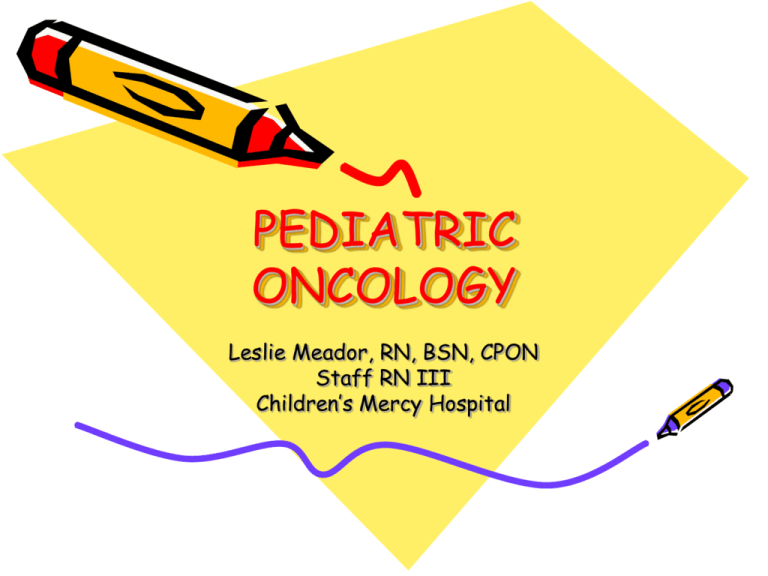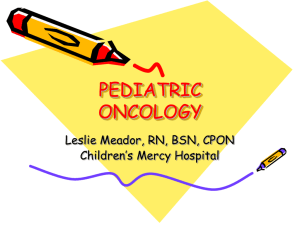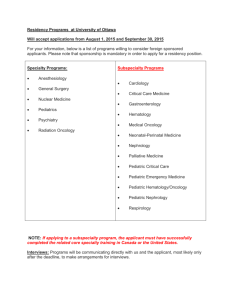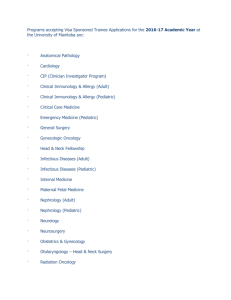pediatric oncology
advertisement

PEDIATRIC ONCOLOGY Leslie Meador, RN, BSN, CPON Staff RN III Children’s Mercy Hospital What is cancer? • Normal cells grow and divide, then eventually die. • Cancer occurs when the body is unable to regulate cell growth, leading to an overgrowth of abnormal cells. Cell development What is cancer? Cell development Healthy growth Normal cells Unhealthy growth Tumor cells Benign Malignant Benign v. Malignant • Benign: overgrowth of cells that are NOT cancerous • Malignant: overgrowth of cells that ARE cancerous Pediatric Oncology Facts • In the U.S., cancer remains responsible for more deaths from one year through adolescence than any other disease; more deaths than asthma, diabetes, cystic fibrosis and AIDS combined. • Each year in the U.S., approximately 12,500 children and adolescents are diagnosed with cancer. That’s the equivalent of two average size classrooms diagnosed each school day. Pediatric Oncology Facts • In the early 1950s, less than 10 percent of childhood cancer patients could be cured. • Today, nearly 80% of children diagnosed with cancer become longterm survivors and the majority of them are considered cured. Pediatric Oncology Facts • Most common childhood cancers: -leukemia (blood) -brain and nervous system -the lymphatic system (lymphoma) -kidneys (Wilm’s tumor) -bones (osteosarcoma & Ewing’s sarcoma) -muscles (rhabdomyosarcoma) Pediatric v. Adult Characteristic Pediatric Adult Frequency Rare: <1% of all cancers Primary sites Involves TISSUE Common: >99% of all cancers Involves ORGANS Pathogenesis Genetic alterations Environment & lifestyle Pediatric v. Adult Characteristic Pediatric Adult Screening/ Early detection Small percentage; screening tests are generally not applicable Many can be detected by adhering to screening guidelines Manifestations at diagnosis Metastatic disease ~80% Local or regional disease Treatment Follows protocols as Doesn’t always standard follow a protocol Prognosis 70-90% cure (depending on tumor & stage) <60% cure (depending on tumor & stage) Means of diagnosis • Well child check-ups (physical assessment & review of symptoms) • Blood tests • Radiology exams (x-rays, CT, MRI) • Pathology (biopsy of mass) • Diagnostic procedures -Bone marrow aspirate -Bone marrow biopsy -Lumbar puncture Bone Marrow Aspiration Methods for treatment • Depends of type and stage of malignancy • Includes the following: -Chemotherapy -Radiation -Surgical resection -Stem cell transplantation Chemotherapy • Chemotherapy can be delivered by the bloodstream to reach cancer cells all over the body, or it can be administered directly to specific cancer sites. • Chemotherapy can be given through various methods: -intravenously (IV) -intrathecally (IT) -intramuscularly (IM) -subcutaneously (SQ) -orally (PO). Chemotherapy • Works by interfering with the ability of cancer cells to divide and reproduce themselves. • Attacks all rapidly dividing cells. Rapidly dividing cells: • • • • Hair Skin Nails Blood cells -Red blood cells -White blood cells -Platelets Three blood lines • Red blood cells: -carry oxygen to surrounding tissues • White blood cells: -fight off infection • Platelets: -help to prevent excessive bleeding; assists in clot formation Complications of chemotherapy • • • • • • • • Anemia (low RBC) Thrombocytopenia (low platelet) Neutropenia (low WBC) INFECTION Hair loss Mouth sores (mucositis) Nausea, vomiting & diarrhea Organ toxicities WHAT DOES CANCER LOOK LIKE? Normal WBC on smear G A E D B H F C A. Banded Neutrophil B. Lymphocyte C. Monocyte D. Segmented Neutrophil E. Eosinophil F. Basophil G. Platelet H: Red blood cell Acute Lymphocytic Leukemia on smear Osteosarcoma Distal Femur Humerus Osteosarcoma Brain tumor Brain tumor The Faces of Childhood Cancer • The Faces of Childhood Cancer WHY this profession? • LOVE KIDS!!!!!! • Hem/Onc - Increased acuity than med/surg units mentally challenging each day; pathophysiology is complex in this population • Opportunity to INVEST in PEOPLE • Develop long-term relations with patients • See effects of my efforts over time • End of life care • Working 3 days/week = Full time!!! What is my day like? • 12 hour shifts; 7am – 7pm • Nurse: patient ratio = 1:3 max • Manage care for each assigned patient, which may include, but not limited to: medication administration, IVF, chemo (monitoring/managing side effects), blood products, procedures (including sedation) for BMA & LP, bone marrow transplant infusions, monoclonal antibodies, ng placement/feeds, IV access, obtaining & monitoring labs, coordinating with other disciplines (PT/OT, speech therapy, radiology, OR) … being PROACTIVE in patient care, focusing on management while preventing further issues/complications. And the numbers are … • Starting salary: $21.49/hr (CMH in top 5% salary for RN’s in KC area) • Shift differentials: 10% evening (311:30pm), 15% nights (7p-7a), 10% weekend • Specialty differentials: 10% critical care, 5% OR, SDS, PACU, $1.00/hr for approved specialty certifications • Up to $3000/year educational assistance References • Hooke, M., Kline, N., O’Neill, J., Norville, R., Wilson, K. (2004). (Essentials of Pediatric Oncology: A Core Curriculum ( 2nd ed.) (pp 2-12,57). Glenview, IL: Association of Pediatric Oncology Nurses • http://www.cancer.org • http://www.childsdoc.org/fall2000/braint umors.asp • http://www.curesearch.org/ References cont. • ghr.nlm.nih.gov/.../ basics/MitosisMeiosis.jpg • http://www.med.harvard.edu/JPNM/TF96_97/No v4/WriteUp.html • http://wwwmedlib.med.utah.edu/WebPath/HEMEHTML/HEM EIDX.html • http://wwwmedlib.med.utah.edu/WebPath/BONEHTML/BON E001.html



